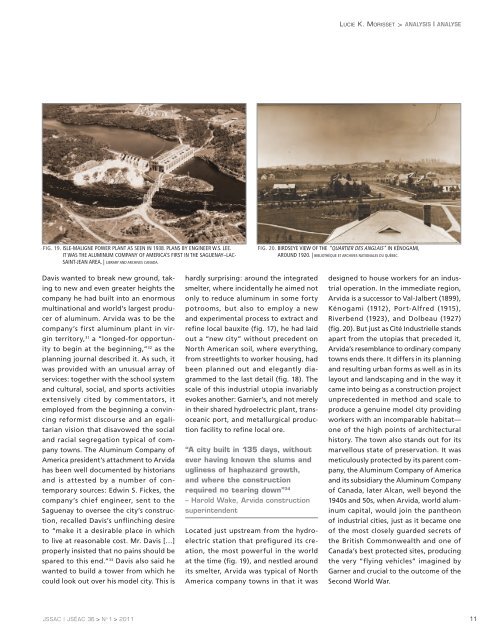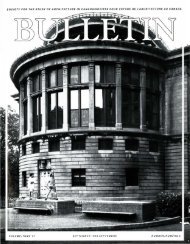'à es us e ct n s, es - Sexton Digtial Initiatives - Dalhousie University
'à es us e ct n s, es - Sexton Digtial Initiatives - Dalhousie University
'à es us e ct n s, es - Sexton Digtial Initiatives - Dalhousie University
Create successful ePaper yourself
Turn your PDF publications into a flip-book with our unique Google optimized e-Paper software.
fig. 19. isle-mAligne POwer PlAnt As seen in 1938. PlAns by engineer w.s. lee.<br />
it wAs the Aluminum cOmPAny Of AmericA’s first in the sAguenAy–lAcsAint-JeAn<br />
AreA. | librAry And Archiv<strong>es</strong> cAnAdA.<br />
Davis wanted to break new ground, taking<br />
to new and even greater heights the<br />
company he had built into an enormo<strong>us</strong><br />
multinational and world’s larg<strong>es</strong>t producer<br />
of aluminum. Arvida was to be the<br />
company’s first aluminum plant in virgin<br />
territory, 31 a “longed-for opportunity<br />
to begin at the beginning,” 32 as the<br />
planning journal d<strong>es</strong>cribed it. As such, it<br />
was provided with an un<strong>us</strong>ual array of<br />
servic<strong>es</strong>: together with the school system<br />
and cultural, social, and sports a<strong>ct</strong>iviti<strong>es</strong><br />
extensively cited by commentators, it<br />
employed from the beginning a convincing<br />
reformist discourse and an egalitarian<br />
vision that disavowed the social<br />
and racial segregation typical of company<br />
towns. The Aluminum Company of<br />
America pr<strong>es</strong>ident’s attachment to Arvida<br />
has been well documented by historians<br />
and is att<strong>es</strong>ted by a number of contemporary<br />
sourc<strong>es</strong>: Edwin S. Fick<strong>es</strong>, the<br />
company’s chief engineer, sent to the<br />
Saguenay to oversee the city’s constru<strong>ct</strong>ion,<br />
recalled Davis’s unflinching d<strong>es</strong>ire<br />
to “make it a d<strong>es</strong>irable place in which<br />
to live at reasonable cost. Mr. Davis […]<br />
properly insisted that no pains should be<br />
spared to this end.” 33 Davis also said he<br />
wanted to build a tower from which he<br />
could look out over his model city. This is<br />
JSSAC | JSÉAC 36 > N o 1 > 2011<br />
hardly surprising: around the integrated<br />
smelter, where incidentally he aimed not<br />
only to reduce aluminum in some forty<br />
potrooms, but also to employ a new<br />
and experimental proc<strong>es</strong>s to extra<strong>ct</strong> and<br />
refine local bauxite (fig. 17), he had laid<br />
out a “new city” without precedent on<br />
North American soil, where everything,<br />
from streetlights to worker ho<strong>us</strong>ing, had<br />
been planned out and elegantly diagrammed<br />
to the last detail (fig. 18). The<br />
scale of this ind<strong>us</strong>trial utopia invariably<br />
evok<strong>es</strong> another: Garnier’s, and not merely<br />
in their shared hydroele<strong>ct</strong>ric plant, transoceanic<br />
port, and metallurgical produ<strong>ct</strong>ion<br />
facility to refine local ore.<br />
“a city built in 135 days, without<br />
ever having known the slums and<br />
uglin<strong>es</strong>s of haphazard growth,<br />
and where the constru<strong>ct</strong>ion<br />
required no tearing down” 34<br />
– Harold Wake, arvida constru<strong>ct</strong>ion<br />
superintendent<br />
Located j<strong>us</strong>t upstream from the hydroele<strong>ct</strong>ric<br />
station that prefigured its creation,<br />
the most powerful in the world<br />
at the time (fig. 19), and n<strong>es</strong>tled around<br />
its smelter, Arvida was typical of North<br />
America company towns in that it was<br />
Lucie K. Morisset > aNalysis | aNalyse<br />
fig. 20. birdseye view Of the “quArtier d<strong>es</strong> AnglAis” in kénOgAmi,<br />
ArOund 1920. | bibliOthèque et Archiv<strong>es</strong> nAtiOnAl<strong>es</strong> du québec.<br />
d<strong>es</strong>igned to ho<strong>us</strong>e workers for an ind<strong>us</strong>trial<br />
operation. In the immediate region,<br />
Arvida is a succ<strong>es</strong>sor to Val-Jalbert (1899),<br />
Kénogami (1912), Port-Alfred (1915),<br />
Riverbend (1923), and Dolbeau (1927)<br />
(fig. 20). But j<strong>us</strong>t as Cité Ind<strong>us</strong>trielle stands<br />
apart from the utopias that preceded it,<br />
Arvida’s r<strong>es</strong>emblance to ordinary company<br />
towns ends there. It differs in its planning<br />
and r<strong>es</strong>ulting urban forms as well as in its<br />
layout and landscaping and in the way it<br />
came into being as a constru<strong>ct</strong>ion proje<strong>ct</strong><br />
unprecedented in method and scale to<br />
produce a genuine model city providing<br />
workers with an incomparable habitat—<br />
one of the high points of archite<strong>ct</strong>ural<br />
history. The town also stands out for its<br />
marvello<strong>us</strong> state of pr<strong>es</strong>ervation. It was<br />
meticulo<strong>us</strong>ly prote<strong>ct</strong>ed by its parent company,<br />
the Aluminum Company of America<br />
and its subsidiary the Aluminum Company<br />
of Canada, later Alcan, well beyond the<br />
1940s and 50s, when Arvida, world aluminum<br />
capital, would join the pantheon<br />
of ind<strong>us</strong>trial citi<strong>es</strong>, j<strong>us</strong>t as it became one<br />
of the most closely guarded secrets of<br />
the British Commonwealth and one of<br />
Canada’s b<strong>es</strong>t prote<strong>ct</strong>ed sit<strong>es</strong>, producing<br />
the very “flying vehicl<strong>es</strong>” imagined by<br />
Garner and crucial to the outcome of the<br />
Second World War.<br />
11

















